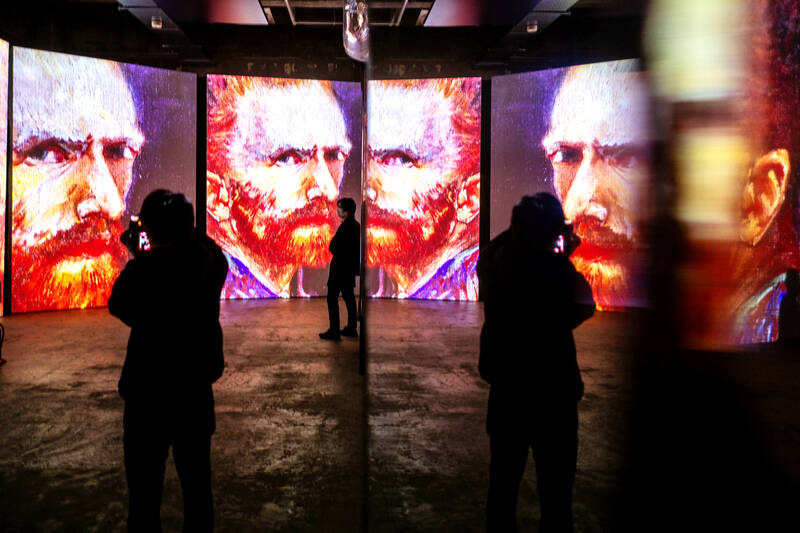From animated floor-to-ceiling paintings to giant fluorescent ball pits, immersive art experiences have proliferated in warehouses, often costing £25-£40 (US$31.75 to US$51) a head. Now experts have claimed that many are overpriced gimmicks.
Leading digital artists have claimed that some of the most popular commercial immersive experiences, particularly those based on the work of deceased artists, such as Van Gogh and Dali, are a money grab that provide little reward to visitors beyond Instagrammable moments.
The proliferation of these shows, which often use relatively old technology, is diluting public perception of what immersive experiences could be and risks sidelining more innovative work, the artists have claimed.

Photo: AFP
ORIGINALITY?
Lucy Hardcastle, a designer and digital artist who runs her own studio in London, said the commercialization of immersive experiences did not leave room for many original ideas.
Hardcastle, who has made work for the Victoria and Albert Museum and Chanel, drew a distinction between commercial experiences like the Van Gogh, Monet and Dali exhibitions, which are primarily screen or projection-based, and more cutting-edge shows where artists have created physical and digital environments from scratch.

Photo: AFP
For example, the work of studio DRIFT, which is led by Dutch artists, includes creating an autonomously moving group of illuminated drones, programmed to fly using an algorithm derived from years of research into starling murmurations. The post-digital art group Random International created
Rain Room — where visitors entered a downpour without getting wet — which attracted tens of thousands of visitors to the Barbican and the New York Museum of Modern Art. These kinds of projects often take years to develop.
In contrast, some of the most popular commercial experiences that opened since these pioneering shows primarily used projection mapping — where displays are projected on to real-world objects or spaces to simulate environments or augment reality — which they had not created and dated back to the 1990s.
“I think things like the Van Gogh experience, and that price point, definitely warps the perception of the craftsmanship that goes into these types of events,” said Hardcastle, who also teaches at Chelsea School of Art.
‘GIMMICKY TAGLINE’
Hardcastle said she thought the word immersive had become “a gimmicky tagline.” Whereas it was once associated with shows that engaged all the senses, it was often now more about creating something that looks good on Instagram.
“It’s almost like our expectations or standards have just continued to become lowered [by these experiences]. And therefore there’s less demand to make something that’s truly outstanding.”
Ralph Nauta, the co-founder of studio DRIFT, also said it was comparatively easy for commercial ventures to make a projected animation of a dead artist’s work. But their own projects, such as Drifter, which involved a floating concrete block, took years of original research.
“To physically — and with the laws of nature — have a block of concrete fly, that’s 15 years of work for that one piece,” he said.
Nauta described popular screen-based immersive experiences as “a money grab,” arguing they did not provide the audience with contemplation or value.
“The visitor walks out and feels, oh, I’m US$50 lighter, but I’ve not experienced anything, I’ve just been put in front of a screen.”
He also questioned whether the dead artists whose work has been turned into immersive experiences would approve of how their work was being displayed.
“It’s like, oh, we do a Van Gogh show, we do a Dali show. Nobody knows if he wanted this. I think it’s very disrespectful. It gives the whole industry a bad name and it can be so, so, so much more.”
SUPPORT LIVING ARTISTS
The artists said the industry needed organizations like the Serpentine and arebyte galleries in London, which has supported emerging artists who work with immersive technology.
Claudel Goy, the managing director of arebyte, said the expansion of commercial shows like the Van Gogh experience had attracted new audiences to immersive art and raised its public profile. But she said there was a need for public institutions to support more cutting-edge work.
Goy said the prices of commercial immersive experiences reflected the high overheads of the technology and the cost of spaces in prime locations of cities like London. Arebyte hopes to open an immersive art museum in east London, with ticketed exhibitions costing up to £15.
“We’re definitely not going to charge £25. Who can afford it? As a family of four, [that’s] £100 — that’s not accessible at all,” she said.
Hannes Koch, a co-founder of the Dutch Random International said artist-led immersive displays could not compete with their more commercial peers because it was far more complicated to create something bespoke than simply use big screens.
He said the ideal price point for immersive experiences was between £8 and £15.
“I don’t think it’s criminal to charge for something that is of high quality. But I think it’s good to keep accessibility high on the radar.”
Sana Ali Aamir, the UK’s general manager for Fever, the company behind Van Gogh: The Immersive Experience, defended the pricing of its most popular exhibitions, which she said helped fund the development of their other newer and more innovative shows, such as such as Dopamine Land and Bubble Planet, which cost about £15-20.
She said that the while the technology involved in the Van Gogh experience was now old, the storytelling in the experience, which takes visitors inside some of his most famous paintings via two-story, 360-degree digital projections, was still powerful and value for money. It was arguably a richer way to experience his work because audiences learned more about the artist, she added.
“The value has been taking that innovation and making it into something that’s more accessible. There’s something for everybody in this market. You can use those expensive things to then drive the more affordable things, which is about giving access to more people and culture,” she said.

The canonical shot of an East Asian city is a night skyline studded with towering apartment and office buildings, bright with neon and plastic signage, a landscape of energy and modernity. Another classic image is the same city seen from above, in which identical apartment towers march across the city, spilling out over nearby geography, like stylized soldiers colonizing new territory in a board game. Densely populated dynamic conurbations of money, technological innovation and convenience, it is hard to see the cities of East Asia as what they truly are: necropolises. Why is this? The East Asian development model, with

June 16 to June 22 The following flyer appeared on the streets of Hsinchu on June 12, 1895: “Taipei has already fallen to the Japanese barbarians, who have brought great misery to our land and people. We heard that the Japanese occupiers will tax our gardens, our houses, our bodies, and even our chickens, dogs, cows and pigs. They wear their hair wild, carve their teeth, tattoo their foreheads, wear strange clothes and speak a strange language. How can we be ruled by such people?” Posted by civilian militia leader Wu Tang-hsing (吳湯興), it was a call to arms to retake

This is a deeply unsettling period in Taiwan. Uncertainties are everywhere while everyone waits for a small army of other shoes to drop on nearly every front. During challenging times, interesting political changes can happen, yet all three major political parties are beset with scandals, strife and self-inflicted wounds. As the ruling party, the Democratic Progressive Party (DPP) is held accountable for not only the challenges to the party, but also the nation. Taiwan is geopolitically and economically under threat. Domestically, the administration is under siege by the opposition-controlled legislature and growing discontent with what opponents characterize as arrogant, autocratic

When Lisa, 20, laces into her ultra-high heels for her shift at a strip club in Ukraine’s Kharkiv, she knows that aside from dancing, she will have to comfort traumatized soldiers. Since Russia’s 2022 invasion, exhausted troops are the main clientele of the Flash Dancers club in the center of the northeastern city, just 20 kilometers from Russian forces. For some customers, it provides an “escape” from the war, said Valerya Zavatska — a 25-year-old law graduate who runs the club with her mother, an ex-dancer. But many are not there just for the show. They “want to talk about what hurts,” she